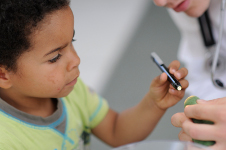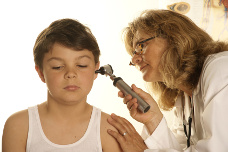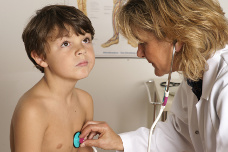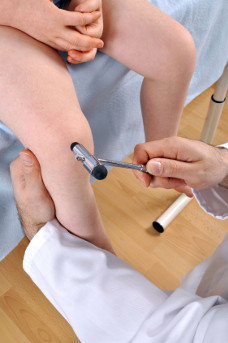Physical exam
Author: Gesche Tallen, MD, PhD, erstellt am: 2007/07/02, Editor: Dr. med. Gesche Tallen, Reviewer: Prof. Dr. med. Ursula Creutzig, English Translation: Hannah McRae, Last modification: 2015/01/13
Prior to every treatment and usually also prior to any other diagnostic procedures, the child or teenager with cancer undergoes a so-called physical exam. This exam does not hurt.
The doctor takes a thorough look at the young patient, palpates certain body regions and uses different devices, such as a stethoscope, an eye and an ear lamp, to name a few, to measure blood pressure, to listen to the sound of heart, lungs and tummy, to check the throat, eyes and ears and to examine certain functions of the brain and spine such as the reflexes.
Also, the doctor will ask the patient, if he/she is in good enough shape, to help assessing the function of certain organs, for example by holding their breath for a moment or by opening their mouth widely or by jumping up and down on one foot.
For every patient, the physical exam usually includes the examination of:
- vital signs (general state, nutritional state, state of consciousness, heart rate, blood pressure, respiratory rate, body temperature)
- developmental state (body weight, body length, head circumference, soft spots (fontanelles), developmental milestones, general behaviour)
- skin (colour, complexion, potential distinctive features (such as cafe-au-lait spots as a sign of Neurofibromatosis Type 1)
- skeleton (posture, skull shape, mobility of joints, possible malformations)
- head and neck (mouth, throat, eyes, nose, ears, cranial nerves - please see also our information on structure and function of the central nervous system)
- heart (sounds), lungs (breathing pattern), abdomen (sounds, palpation of spleen and liver)
- loins (to check on possible kidney problems)
- privates (developmental state, to detect possible malformations)
- muscle function (strength and tone, possible palsies)
- reflexes
- sensibility (for example sensibility of the extremities to touch and temperature)
- coordination (gait, jumping on one leg, penmanship to name a few)
- language and speech (sound of words, rhetorical skills etc.)
Note: Although a physical exam follows a certain pattern, every doctor may have her/his own routine. This means, that the physical exam for your child might differ a little bit from the pattern described above.




